System and method for detecting content similarity within emails documents employing selective truncation
- Summary
- Abstract
- Description
- Claims
- Application Information
AI Technical Summary
Benefits of technology
Problems solved by technology
Method used
Image
Examples
Embodiment Construction
[0017]Turning now to FIG. 1, a block diagram of one embodiment of a computer system 100 is shown. Computer system 100 includes a storage subsystem 110 coupled to a processor subsystem 150. Storage subsystem 110 is shown storing an email database 120 and similarity detection code 130. Computer system 100 may be any of various types of devices, including, but not limited to, a personal computer system, desktop computer, laptop or notebook computer, mainframe computer system, handheld computer, workstation, network computer, a consumer device such as a mobile phone, pager, or personal data assistant (PDA). Computer system 100 may also be any type of networked peripheral device such as storage devices, switches, modems, routers, etc. Although a single computer system 100 is shown in FIG. 1, system 100 may also be implemented as two or more computer systems operating together.
[0018]Processor subsystem 150 is representative of one or more processors capable of executing similarity detecti...
PUM
 Login to view more
Login to view more Abstract
Description
Claims
Application Information
 Login to view more
Login to view more - R&D Engineer
- R&D Manager
- IP Professional
- Industry Leading Data Capabilities
- Powerful AI technology
- Patent DNA Extraction
Browse by: Latest US Patents, China's latest patents, Technical Efficacy Thesaurus, Application Domain, Technology Topic.
© 2024 PatSnap. All rights reserved.Legal|Privacy policy|Modern Slavery Act Transparency Statement|Sitemap



